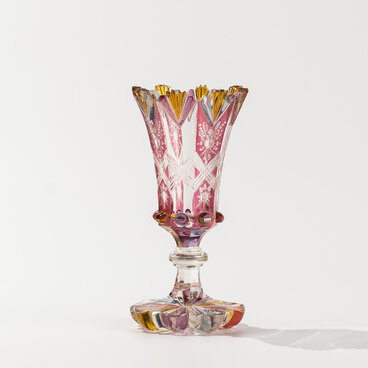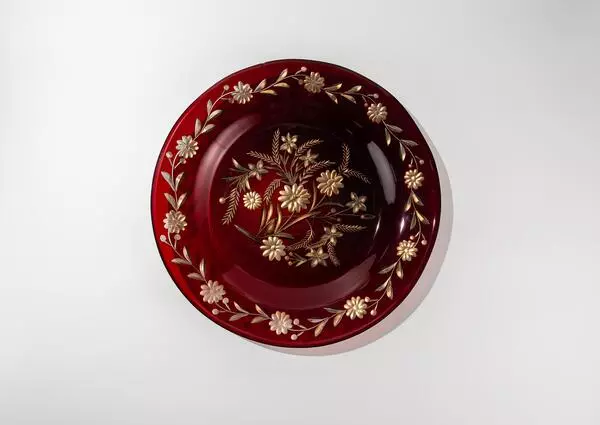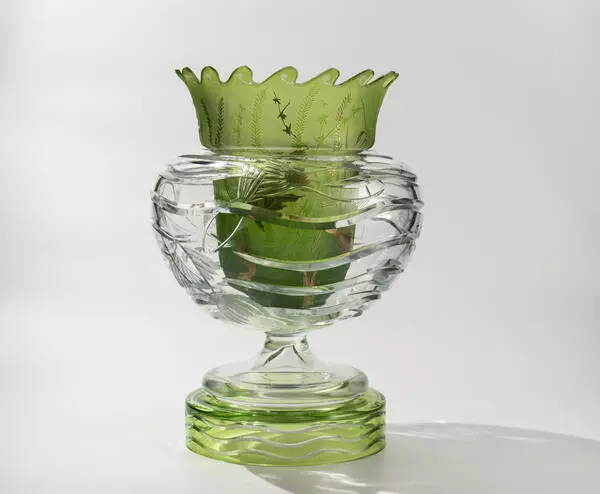A powder box is a container for storing powder. This box belongs to a dressing table set from the museum collection. The set also includes perfume bottles and a case for cosmetics. An older term for a dressing table is a toilet table. The word “toilet” came from the French “toile” meaning “cloth” and initially meant “dress” or “outfit”. Therefore, a toilet table is a place for dressing. Such tables became part of the everyday life of wealthy women in the 18th century when applying make-up became a widespread and enjoyable ritual. Brightly decorated items from a dressing table set are designed to bring joy to their beautiful owner every day and help her become more and more beautiful.
This dressing table set was designed by Anna Lipskaya, an Honored Artist of the Russian Soviet Federative Socialist Republic (RSFSR). In 1927, she graduated from the Higher Artistic and Technical Institute. For almost 20 years, she was the chief artist of the Main Directorate of the Glass Industry at the Ministry of Light Industry of the RSFSR and USSR. In this position, Anna Lipskaya participated in the development of new shapes and decoration styles for items made of various types of glass. Under her leadership, the industry introduced new prototypes and defined the criteria which determined the appearance of glass products from the late 1930s until the 1960s. At the Dyatkovo Crystal Factory, Anna Lipskaya designed around 50 products, with many of them presented in the museum collection.
The dressing table set was designed by Anna Lipskaya in 1950. The powder box was made of colorless glass and painted golden-yellow after cooling down. The delicate golden color was achieved with the help of a diffusion coloring technique. A finished product is covered with a special paste and annealed, and after that, the paste is washed off. The glass is annealed at a temperature of 550–570 ºС, which is lower than the deformation point. The paste contains silver and copper compounds, carefully dried and powdered additional materials, including clay, chamotte, kaolin, or ocher, as well as binding agents, such as turpentine or oil. Silver ions from the paste enter the surface layer of the glass and color it evenly, giving the glass a golden color. Apart from silver etching, the powder box was decorated using deep-cut patterns and gold painting. This was typical of the 1950s when the trends included elaborate decoration and lavish appearance.
This dressing table set was designed by Anna Lipskaya, an Honored Artist of the Russian Soviet Federative Socialist Republic (RSFSR). In 1927, she graduated from the Higher Artistic and Technical Institute. For almost 20 years, she was the chief artist of the Main Directorate of the Glass Industry at the Ministry of Light Industry of the RSFSR and USSR. In this position, Anna Lipskaya participated in the development of new shapes and decoration styles for items made of various types of glass. Under her leadership, the industry introduced new prototypes and defined the criteria which determined the appearance of glass products from the late 1930s until the 1960s. At the Dyatkovo Crystal Factory, Anna Lipskaya designed around 50 products, with many of them presented in the museum collection.
The dressing table set was designed by Anna Lipskaya in 1950. The powder box was made of colorless glass and painted golden-yellow after cooling down. The delicate golden color was achieved with the help of a diffusion coloring technique. A finished product is covered with a special paste and annealed, and after that, the paste is washed off. The glass is annealed at a temperature of 550–570 ºС, which is lower than the deformation point. The paste contains silver and copper compounds, carefully dried and powdered additional materials, including clay, chamotte, kaolin, or ocher, as well as binding agents, such as turpentine or oil. Silver ions from the paste enter the surface layer of the glass and color it evenly, giving the glass a golden color. Apart from silver etching, the powder box was decorated using deep-cut patterns and gold painting. This was typical of the 1950s when the trends included elaborate decoration and lavish appearance.




